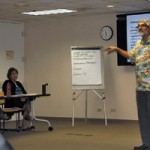Planning For A Healthier Community
At a time when many don’t know how they would potentially benefit from the Affordable Care Act, popularly dubbed “Obamacare,” Kaua’i residents are getting the chance to chime in on just what those benefits could be.
That’s thanks to the Kaua’i District Health Office and Wilcox Memorial Hospital, which recently have gone above and beyond to assess the health care needs of local residents using what Dr. Dileep Bal, Kaua’i district health officer, calls an “upstream” strategy.
“An ‘upstream’ focus is based on factors outside the health care system, which impact health infinitely more than the health care system itself – work-place, schools, community centers. Thus the impact of factors like education, transportation, income, housing and cultural beliefs are central to the population’s health,” Bal says.
- Dr. Dileep Bal introduces the subject of health care needs assessment | Amanda C. Gregg photos
- Kelly Knudsen and Clara Mackler at a meeting of the Kaua‘i Developmental Disabilities Council
- Toni Torres takes notes at a Kaua‘i Developmental Disabilities Council meeting
Taking an islandwide, grassroots approach to analyzing Kaua’i health care needs, several key focus groups recently answered some basic questions about Kaua’i’s strengths and weaknesses when it comes to health care and overall wellness.
Conducting such community health needs assessments (CHNA) is a requirement under the Affordable Care Act, but how they are being conducted varies widely across the state.
The Garden Isle is the only island in Hawaii to receive hands-on, health care needs assessment in recent weeks, as other islands relied on Internet surveys and consultants to gather information. Using focus groups is an approach that Bal is proud of, one he says will help define the future of health care for Kaua’i residents.
“The other islands have shortchanged their populations by not directly consulting their end-users,” Bal says. “Hawaii’s other hospitals not only did not solicit direct community input, but ignored the community-building component of the law.”
At a time when nonprofit hospitals are being asked to develop community out-reach under Obamacare – the tax code now requires nonprofit hospitals to consult with the community at large in order to keep their federal tax exempt status – not all have done so.
“In my view, the other islands might be in violation of the IRS community health needs assessment requirements of the Affordable Care Act,” Bal says. For that reason, Bal lauds Wilcox as the “only hospital that embraced the letter and spirit” of Obamacare.
Bal also credits partnerships with Mayor Bernard Carvalho, schools superintendent Bill Arakaki, Kaua’i Community College chancellor Helen Cox, County Councilwoman Nadine Nakamura, state Rep. Dee Morikawa, the Governor’s Office on Kaua’i and staffers Naomi Sugihara and Toni Torres for pulling off the successful outreach, which has resulted in ample data from locals throughout the island.
Sugihara and Torres recently hosted the 15 “talk story” focus group sessions islandwide. Topic questions ranged from, “What does good health mean to you?” and “What strengths do we have in our community that improve health?” to “What are your visions, ideas or images of a healthy Kaua’i?” and “What are some of the challenges to having good health?”
The initial plan was to identify 10 groups on the island, but expanded, Sugihara says. “We ended up meeting with 15 groups, which included older adults, special target populations, members from the Native Hawaiian and Filipino populations, and youths, along with two general-public meetings.
We especially tried to reach out to populations who may not come to public meetings or may not have an opportunity to have a ‘voice’ in sharing their thoughts of the health of Kaua’i’s people.”
Findings from a recent Lihu’e public meeting illustrated that residents believe good health means access to services, focusing more on prevention and being free from disease or injury.
Across town in Kapa’a, residents identified visions of a healthier future Kaua’i as including the expansion of the bike path in both directions, and alternate highway plans out of flood zones, including routes out of Hanalei. They also expressed hope for an end to the blight at Coco Palms.
Targeted demographics identified several areas where Kaua’i needs improvement. Chief concerns varied from a lack of specialized doctors on island to unhealthy farming practices such as GMO and pesticide usage, to a lack of facilities for long-term care. Tobacco use, physical inactivity and the obesity epidemic also were major concerns.
Participants also identified health care challenges such as a lack of oncologists, the high cost of health insurance, and noise problems such dogs and roosters interrupting healthy sleep patterns.
Sugihara says she believes that, overall, the meetings were successful. “Participants expressed their appreciation for the opportunity to provide input into the assessment process and are looking forward to hearing about the outcomes of the priorities for Kaua’i’s CHNA plan,” she says.
Bal says a report currently is being compiled with the intention that data from the focus groups and health statistics will be implemented as health care priorities for Kaua’i.
“The report will illustrate why your ZIP code could be a better predictor of your future health than your genetic code,” he says.






